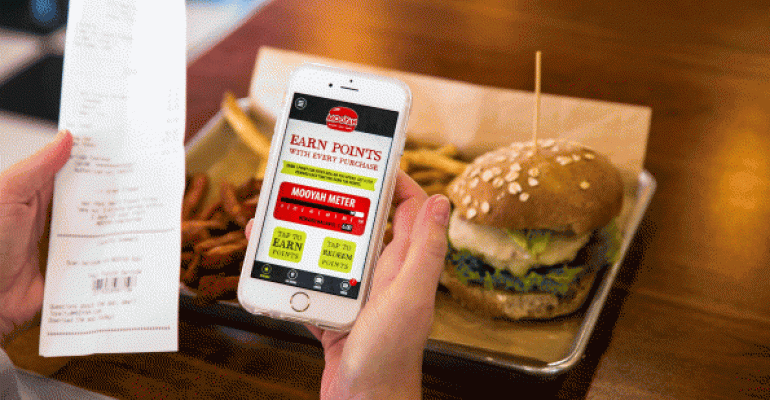
Restaurant operators have long been trying to figure out the secret recipe for loyal customers — those devoted diners who visit often and eagerly spread the brand gospel.
New research from global market research firm The NPD Group offers insights into why loyal customers are so sought after, and what operators should — and shouldn’t — do to keep them coming back.
“For so long, restaurant operators haven’t had data to understand the lifetime value of customers. You can quantify it now,” said Elizabeth Journell, executive director of business development at NPD. “The restaurant industry is going to get clearer on who is loyal to them and focus on them. There’s big money to be made here if you understand that.”
Indeed, the latest research from Port Washington, N.Y.-based NPD’s QSR Market Monitor reveals just how important loyal customers, or loyals, are to restaurants. According to the data, loyals frequent a chain on average four times more often than non-loyals, making them a lucrative group to target. For example, loyals make an average of 61 annual visits to quick-service restaurants, compared with non-loyals, who make an average of just 15 annual visits.

In addition, loyals have a strong commitment to a brand, and are far more likely than non-loyals to recommend a place, specific food or beverage. According to NPD data, 89 percent of loyals are very/somewhat likely to recommend a particular place, compared with 36 percent of non-loyals; 80 percent of loyals are very/somewhat likely to recommend a specific food compared with 27 percent of non-loyals; and 55 percent of loyals are very/somewhat likely to recommend a beverage compared with 16 percent of non-loyals.
What inspires this loyalty? Good food and quality offerings at affordable prices, good service and atmosphere, and promotions are the top drivers behind restaurant customer loyalty, NPD found.
“They’re so important to you,” said Journell. “They are the ones that speak on your behalf. If you lose them, that affects the brand.”
Perhaps no other brand exemplifies Journell’s sentiment better right now than Chipotle Mexican Grill, which grew a cult-like following built on the promise of “Food With Integrity.” But when a series of foodborne illness outbreaks occurred at the chain starting in February 2015, many loyal customers saw the promise as broken and began to avoid the chain.
Customer loyalty at Chipotle has been slipping since the outbreaks began, NPD data reveal. In the four-week period ending January 2015, before consumers began reacting to the events, Chipotle customers allocated 9.5 percent of their quick-service/fast-casual visits to Chipotle. This measure has since declined to 7.7 percent in the four-week period ending May 2016.
“A 2-percent drop in customers going to you is crazy — really, really big,” said Journell.
In addition, NPD found that Chipotle’s net promoter score — the percentage of consumers with a high likelihood to recommend a brand minus the percentage of consumers who are not likely to recommend the brand — also declined significantly. In the four-week period ended January 2015, Chipotle’s net promoter score was 36.8 percent, but it has since plummeted to 14.9 percent in the four-week period ended May 2016.
“Whoever you are, whatever your brand promise, anytime catastrophe hits, go back to your roots, be true to yourself,” advises Journell. “Communicate what you’re going to do to change it.”
Building a following
While Chipotle wrestles with how to re-build loyalty, two growing fast-casual chains, Culver’s and Mooyah Burgers, Fries & Shakes, share some tactics that have helped them grow loyalty.
Mooyah Burgers, Fries & Shakes
Mooyah has been building customer loyalty with a combination of innovative and traditional approaches. In March, the fast-casual burger chain launched a loyalty app that is fully integrated into its POS system, which provides the chain with detailed information about customers’ purchase and visit behavior, food preferences, and more.
“We can see the high-value people and talk to them,” said Natalie Anderson Liu, vice president of marketing at Mooyah. “Before the app, we’d have no idea.”
To date, more than 100,000 people have downloaded the app and made more 18,650 referrals for their friends to join. With the chain’s app users spending on average 5 percent more than non-users, these are very valuable customers, said Anderson Liu.
But Mooyah isn’t counting on technology alone. Anderson Liu said the chain is still very much focused on delivering the best burger, fry and shake experience possible, as well as continuing to support customer causes through localized fundraising events.
“Restaurants that are the top 10 in fundraisers are the top 10 in sales,” said Anderson Liu. “It really does convert loyal users.”
Culver’s

Cooked-to-order burgers made with fresh ingredients, hyper-friendly service and a passion for cheese curds are among the many factors that keep customers coming back to Culver’s, which says it has grown brand awareness, sales and loyalty in the last several years.
“It was taking a look at our core values and realizing that our marketing message maybe wasn’t hitting the mark,” said Emily Patterson, director of marketing at Culver’s. “Since the launch of Welcome to Delicious [campaign in 2011], we’ve really focused on keeping the main thing the main thing. Staying true to who we are.”
In addition, the chain also offers a number of innovative programs designed to inspire loyalty and grow engagement, including an e-club, text club and a mobile app. But it’s about something more than that, Patterson said.
“It’s so important to get loyal guests to come back more often,” she said. “It’s really about recognizing that person, treating them a little differently.”

